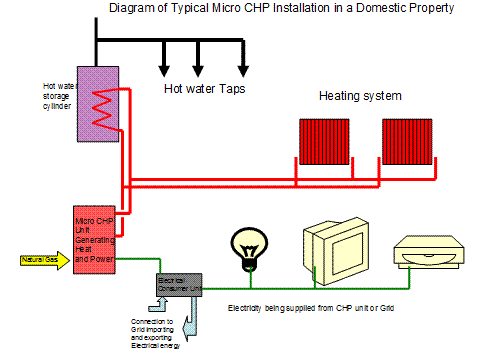|
Cold weather results in freezing conditions and often loss of electrical power. How much longer will the public have to put up with this problem? Believe it or not help is on its way and boilers are being developed that will not only heat your house and provide hot water but they will also generate electricity. The boilers are called micro Combined Heat and Power units and they will fit in the space of a traditional wall mounted boiler. Because they reduce the overall carbon emissions they will also qualify for the Government’s Feed In Tariff (FIT) scheme, which will means you will get paid for generating the electricity and you will also get paid for the energy you can export back to the grid. It all sounds too good to be true but the Government is gearing up to give help in the initial period to the first 30,000 installations.
The Big Picture
Providing energy to our homes is always going to be a necessity and with the increased demand for housing the infrastructure of our utilities is taking the strain. You may think that surely all this extra load requirement is good for the utility providers. Well it is if they have spare capacity in their networks but, in 90% of the cases it is a problem. To increase the distribution system can cost millions of pounds, require long lead in times for projects and in some cases public enquires are required where Civil Engineering work ploughs through sensitive areas.
So the Utility providers are keen to find ways in which they can stretch their assets and save them money.
Load profiles have changed over time
Over the years the load profile of a typical home has changed. People are demanding higher comfort standards, better lighting, more automation and communication. They need this service 24 hours a day 7 days a week and with no interruption.
Better insulation and building materials has reduced heating requirements, low energy lighting and appliances have reduced electrical loads but in many situations these have become more of a base load because equipment like computers run more continuously. Generally the base electrical load on a domestic property excluding the heating is on average is around 1kW.
Micro CHP
Scientists and Engineers have for some time being trying to develop a new boiler which can fulfil the modern day requirements and at last they have cracked the problem by using fuel cell technology. Fuel cells convert fuel and air directly into power through a quiet, efficient, solid-sate electro-chemical reaction. The type of fuel used and the operating temperature allow electricity to be generated by a chemical reaction instead of burning the fuel. The fuel is natural gas or LPgas. The efficiency can save the consumer around 25% of the total energy costs and reduce each home’s CO2 emissions by up to 1.5 tonnes pa. A typical Micro CHP unit could generate 1kW of electricity and under the Government incentive FIT scheme you would get 12.5p for every kWh of electricity produced plus you will get a further 3p per kWh for the energy you export back to the grid. Unlike wind power, solar power and wave power the energy Micro CHP is available 24 hrs/day.
How does the CHP unit fit in to my existing heating, hot water and electrical system.
The diagram below shows a typical domestic energy system. The wall mounted Micro CHP system replaces your existing boiler and connects to the radiators, hot water cylinder and electrical distribution board.

When will I be able to get this Technology?
Currently the boilers are undergoing intensive testing and as with any new product it is important to get it right before the units are being mass produced. But it is about 18 months time when we could see this entering the market big time. Watch this space in the future because our Engineering Team is monitoring this new development in CHP very closely and will be issuing an update in the future as the success of this unfolds.
|

